The best in many parameters are cast iron heating radiators. Characteristics and installation
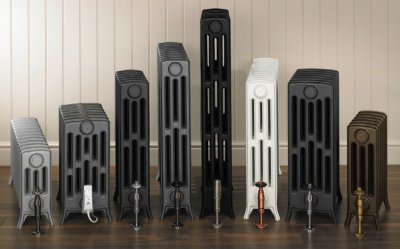
Cast iron radiators are devices for heating rooms.
Widely used due to good heat transfer and low price.
Nowadays, there are decorative designer models of radiators that are able to decorate any interior.
Content
Technical characteristics comparison table
Below is a table describing the characteristics. several types heating radiators.
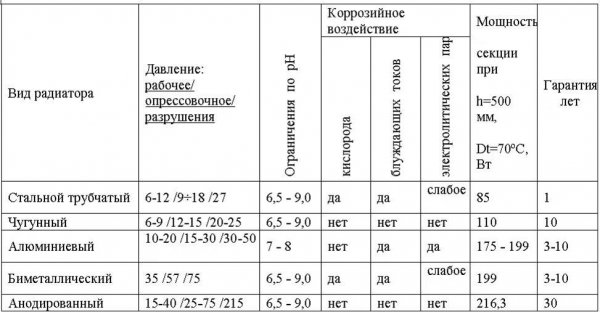
Photo 1. Table of comparative characteristics of several types of radiators: steel, cast iron, aluminum, bimetallic and anodized.
Dimensions
Each cast iron radiator has 4 linear characteristics:
- The center distance of the radiator is from 250 to 600 mmBatteries made of other metals have a wider range.
- The height of the radiator is at least greater than the previous figure 80 millimeters.
- The thickness varies between 85 and 185 mm.
- The width of the products is usually about 10 cm, but sometimes less.
Considering the wide range of dimensions, you can select a battery for a wide range of rooms, with different volumes. Thus, low devices are suitable for rooms with high windows and vice versa.
Algorithm for calculating thermal power by area
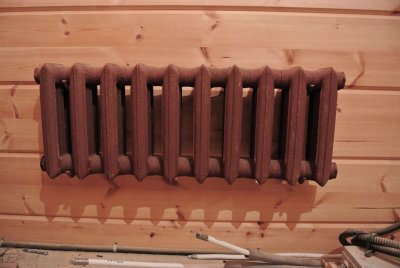
It is believed that for every square meter there is enough housing 100 watts.
The total value is obtained by multiplying the area of the room by the specified indicator.
Next, select the size of the sections from which the battery will be assembled. Dividing the previously obtained value by the nominal value, you will get the required number of components.
Heat output of one section of a cast iron radiator
If you choose a medium-sized battery, the heat output indicator will be 150 watts. The indicator changes along with the dimensions of the device. The value rarely exceeds 180 W or falls below 135.
Corrosion resistance level
The average values are presented in the table.
| Corrosion resistance (mm/year) of cast iron | |||||||||
| Cast iron | terms of Use | ||||||||
| Industrial environment | Chamber with 0.3% SO2 additive2 | Flowing liquid at 25 °C | Sea water* | 10% at 50°C | 3% at 10-19 °C | 5% acid | |||
| sulfuric | salt | nitric | |||||||
| White | — | — | — | 0.05 | — | — | — | — | — |
| Grey | 0.14 | 0.24 | 0.27 | 0.06 | 0.02 | 0.08 | 31 | 27 | 26 |
| Lasting | — | — | — | — | — | — | — | — | — |
| ferrite | 0.18 | 0.29 | 0.22 | 0.06 | 0.01 | 0.08 | — | — | — |
| ferrite and pearlite | 0.18 | 0.24 | 0.26 | — | — | 0.08 | — | — | — |
| perlite | 0.14 | 0.22 | 0.29 | 0.06 | 0.01 | 0.08 | — | — | — |
| Malleable | — | — | — | 0.06 | — | — | — | — | — |
| Corrosion-resistant type 4N 15D7 | — | — | 0.05 | 0.02 | — | — | 0.15 | 0.3 | 21 |
| Siliceous ChS 15 | — | — | — | — | — | — | 0.13 | 0.13 | — |
| *When tested in running water, corrosion is higher. The rate is 1 g/(m2∗h) = 1.2 mm/year. | |||||||||
Design as a selection factor
Cast iron radiators are rarely made beautiful. Their job is to transfer heat, not to please the eye. But some radiators are stylized, and then with their help they create a beautiful interiorThis is facilitated by an unusual shape or coloring over a standard primer.
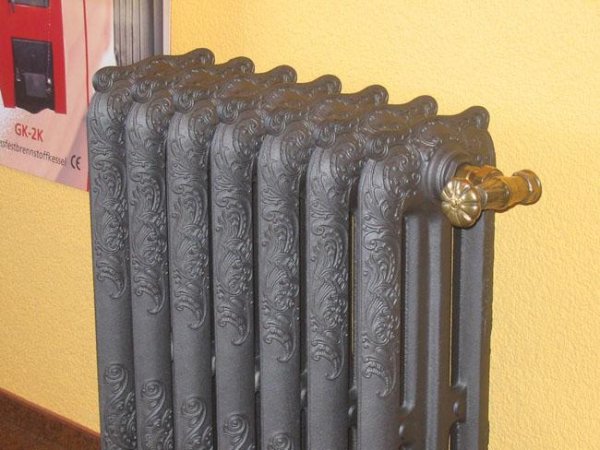
Photo 2. Decorative heating radiator made of cast iron. Covered with black paint, decorated with decorative forging.
Some batteries are made in a retro style. They are decorated with an ornament and given a dark color. The radiators themselves have wheels, so it is enough to put them on the floor without attaching them to the wall.
AND They also create abstract models of radiators. The main component is cast iron, but it is combined with another metal. They are produced in various forms, so such batteries are suitable for any room.
How many years is the service life
The guaranteed service life of cast iron radiators is 50 years oldIn rare cases this value is higher: due to corrosion the actual operating time is lower.
Operation of modern heating batteries with water
There are 7 characteristics, which distinguish cast iron from other metals:
- Durability
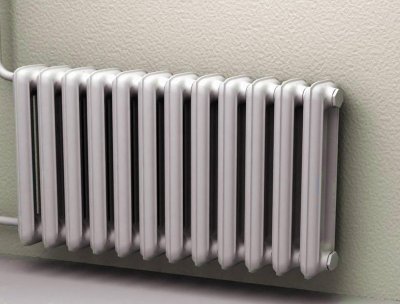
The device's resource is exhausted for a very long time, since it is capable of performing its function efficiently 50 years and older.
In some cases, no repairs are carried out during this period. Given the low cost, this results in a cheap system that requires almost no maintenance costs.
- High heat output
Among other materials, cast iron tolerates water temperature in the environment better than others. This is due to the vertically positioned section ribs. The design and parameters of the metal allow the radiators to operate for a long time even when the boiler is turned off or the quality of its operation is lost.
- Ability to withstand strong heating of the coolant
Cast iron radiators can easily withstand temperature increases up to 130-140 degrees, which allows using water vapor as the working substance. Although this is unreasonable, and such values are excessive.
- Modern radiators have high safety margin
The capacity of the devices is protected from external physical damage. The internal part of the system is capable of withstanding the operating pressure up to 18 atmThis helps with hydraulic tests where high values are pumped.
- Corrosion resistance
The latter is possible due to the iron contained in the alloy. To neutralize this problem, the inner walls are coated with a special substance. Thanks to the preparation, the oxygen released from the steam during strong heating does not interact with the metal. Then, as it cools, it again combines with hydrogen, becoming liquid.
- High hydraulic resistance
The indicator depends on the diameter of the pipes that supply water to the radiator. For cast iron, the value is high, so there is no need to use a circulation pump. The liquid makes itself travel through the system quite easily.
Attention! The device supports operation with any type of coolant. The cast iron piping can be filled with either water or mixtures containing glycol.
- Low cost of the device and ease of installation
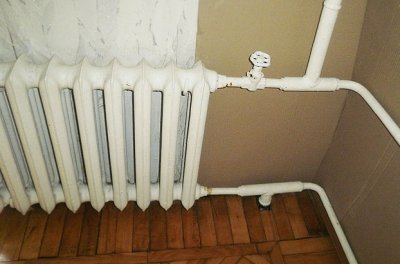
Cast iron radiators have built-in connections: It is enough to hang the battery on hooks that are embedded in the wall and connect it to the pipes.
This method of fastening is reliable, guarantees the absence of leaks, reduces the risk of water hammer. The latter can sharply increase the pressure and cause irreparable damage to the device.
System connected to the piping with threaded connections, which is safer than welding. It also allows you to combine different metals, such as cast iron sections with steel pipes. Despite the ease of installation, it is recommended to invite a specialist.
Features of decorative radiators
Designer products do not have such good technical indicators:
- Heat output is slightly lower, which is associated with an additional layer of paint, in some cases - an ornament.
- Average power is less, since the dimensions are often cut down. This helps to create an interior, but interferes with the direct purpose of the battery.
- Hydraulic resistance drops, because the pipes are made small and neat.
- Unlike simple radiators, decorative ones significantly more expensive.
The listed features look negative, but beauty requires sacrifice. Problems are easy to solve minor design changes or combining radiator heating with another.
Useful video
Watch the video which talks about the advantages and disadvantages of cast iron heating radiators.
It's hard to cope on your own
Selecting batteries is a complex process that requires time. Expert advice will help you save money.





